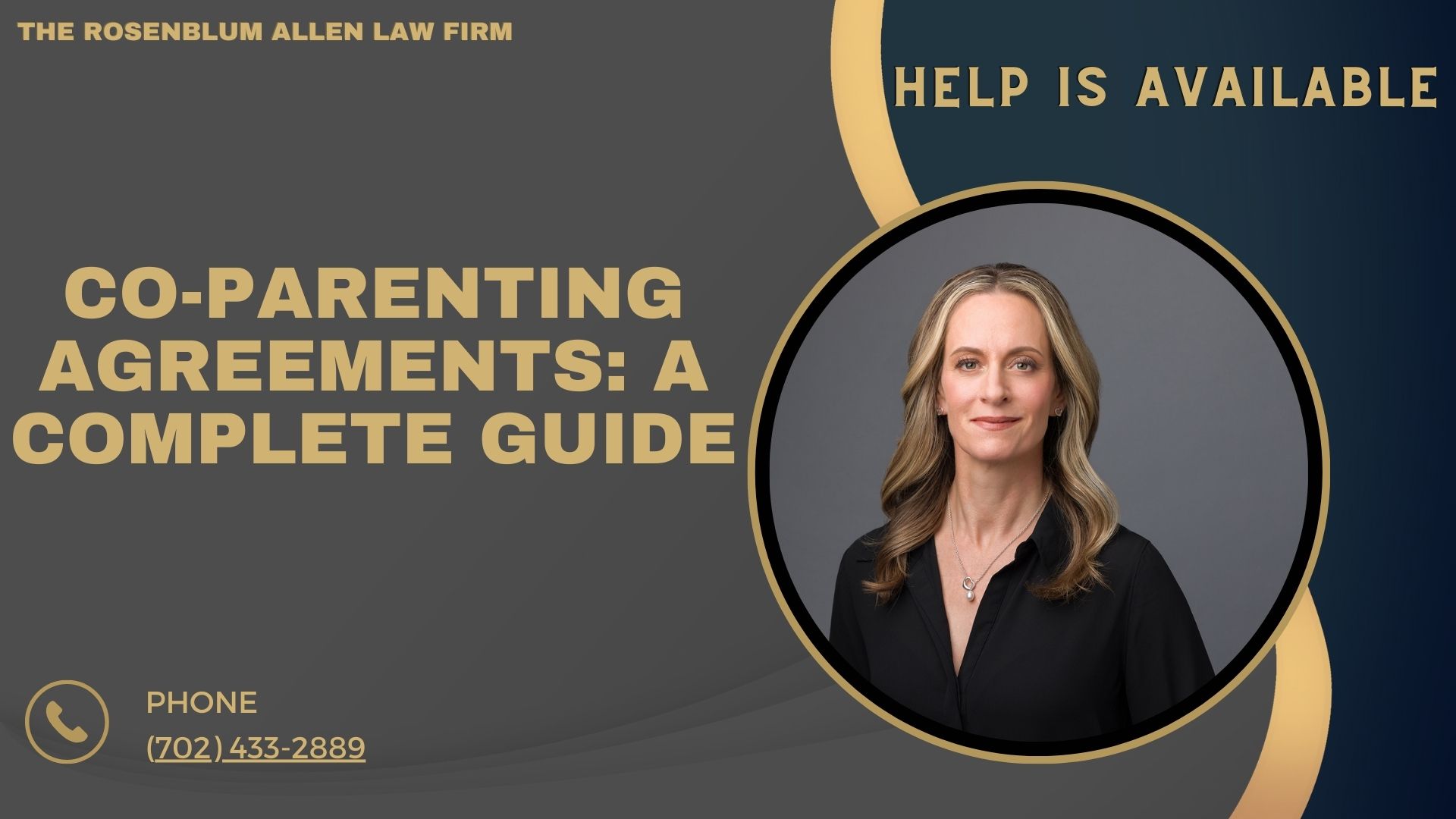When parents separate or divorce, they need co-parenting agreements. These are essential tools for ensuring their children’s well-being. These agreements outline many aspects of co-parenting. They cover parenting schedules, decision-making authority, financial obligations, communication guidelines, and more. Co-parenting agreements establish clear expectations and procedures. They help parents navigate new roles and duties. They promote stability and harmony for the children involved.

Establishing the Core Elements
Parenting Time and Visitation Schedules
Regular Visitation: Setting up consistent visitation schedules helps provide stability for children.
Holiday and Vacation Arrangements: Determining how holidays and vacations will be shared ensures fair and equitable time for both parents.
Flexibility and Modifications: Flexibility is critical in co-parenting agreements, allowing for adjustments as circumstances change.
Decision-Making Authority
Allocating Responsibilities: Clearly defining who has decision-making authority for various aspects of the child’s life, such as education, healthcare, and extracurricular activities.
Major Life Decisions: Addressing how major decisions will be made, including issues like schooling, religious upbringing, and medical treatment.
Dispute Resolution: Establishing mechanisms for resolving disputes that may arise regarding decision-making, such as mediation or arbitration.
Child Support and Financial Obligations
Calculating Child Support: Determining the financial support each parent is responsible for based on income and other factors.
Additional Expenses: Addressing how additional expenses, such as medical bills, extracurricular activities, and educational costs, will be divided between the parents.
Review and Adjustment: Regularly reviewing and adjusting child support and financial obligations as circumstances change, such as income or expenses.
Communication Guidelines
Open Communication: Emphasizing the importance of open, respectful communication between co-parents for the well-being of the children.
Communication Methods: Specifying preferred methods of communication, such as phone calls, emails, or co-parenting apps.
Emergency Contact Information: Ensuring both parents have access to emergency contact information for each other and other relevant individuals, such as doctors or caregivers.
Education and Healthcare
Schooling and Education: Determining where the child will attend school and how educational decisions will be made.
Healthcare Providers: Select healthcare providers and outline how medical decisions will be made, including routine care and emergencies.
Handling Emergencies: Establishing procedures for handling medical emergencies and ensuring both parents are informed and involved in the decision-making process.
Relocation and Travel Arrangements
Notification Requirements: Addressing requirements for notifying the other parent in case of temporary or permanent relocation.
Travel Consent: Establishing guidelines for parental consent for domestic and international travel.
Interstate or International Travel: Considering the unique challenges and requirements of travel across state or national borders.

Crafting and Negotiating Agreements
Making a co-parenting agreement is a team effort. It requires careful thought and negotiation. Here’s how to navigate this important step:
Working with Legal Professionals
Seeking guidance from family law attorneys can provide invaluable support. They are experienced in co-parenting agreements. They can offer legal expertise and mediation services. They ensure that the agreement meets legal requirements.
Identifying Parental Needs and Priorities
Take the time to understand each parent’s concerns, preferences, and priorities. This may involve discussing schedules, money, and parenting styles. The goal is to find common ground. This will ensure that the agreement reflects the child’s best interests.
Documenting the Agreement
Once the key parts of the co-parenting agreement are agreed upon. You must write them down. A written agreement brings clarity. It’s a reference for both parents going forward. Make sure the document covers all aspects of co-parenting. Review it carefully before finalizing.

Implementation and enforcement
Implementing and enforcing a co-parenting agreement requires ongoing communication, cooperation, and flexibility. Here’s how to ensure the agreement is followed:
Ensuring Parental Compliance and Cooperation
Both parents must commit to the co-parenting agreement’s terms. They must work together to resolve any disagreements or conflicts that arise. Communication is key. Keeping a respectful and cooperative relationship is vital for the children’s well-being.
Monitoring and Adjusting Agreements
As things change, children grow older and parents’ schedules evolve. The co-parenting agreement may need to be reviewed and adjusted. Check it often. Make changes when needed. This ensures it stays useful.
Seeking legal help.
If disputes or disagreements can’t be resolved peacefully, you may need legal help. Family law attorneys can help with complex legal issues. They can mediate disputes. They ensure the co-parenting agreement is enforced through the legal system when needed.
Implementing and enforcing a co-parenting agreement requires both parents’ commitment, communication, and cooperation. By working together and prioritizing the children, parents can create a supportive environment. It will be stable and will foster their children’s well-being and happiness.

Breaking It All Down
In conclusion, co-parenting agreements are vital for divorced or separated parents. They help them navigate their new roles and duties. They do this while putting their children first. Clear guidelines and expectations help. They let parents create a supportive co-parenting environment. This environment promotes harmony and happiness.
Creating a co-parenting agreement involves many parts. These include parenting schedules, decision-making power, financial obligations, communication rules, and more. You need to work with legal professionals. You also need to consider each parent’s needs and priorities. This is essential for making a good agreement.
Once the agreement is in place, parents must commit to its terms. They must also work together to resolve any disputes or conflicts. Regular communication, flexibility, and cooperation are essential to successful co-parenting.
Finally, review and adjust the co-parenting agreement as things change. This keeps it relevant and practical. Seeking legal help can resolve disputes. It can also enforce the contract in court.
In the end, a co-parenting agreement aims to give kids a stable environment. It should help them thrive despite their parents’ separation. Parents can create a good co-parenting relationship. They just need to put their children first and work together. This benefits everyone involved.

Frequently Asked Questions
What is a co-parenting agreement?
A co-parenting agreement is a written document. It outlines the duties and expectations of divorced or separated parents. It covers the care and upbringing of their children.
Why are co-parenting agreements important?
Co-parenting agreements are crucial. They provide clarity and structure for co-parenting. This helps to cut conflicts and put the kids first.
How do I create a co-parenting agreement?
Creating a co-parenting agreement involves open communication. It also requires negotiation and often working with lawyers. Many factors must be considered. These include parenting schedules, decision-making authority, financial obligations, and communication guidelines.
What should be included in a co-parenting agreement?
A co-parenting agreement should cover many things. It should cover time for parenting. Also, decision-making, support, communication, education, healthcare, and travel.
How can I ensure that both parents adhere to the co-parenting agreement?
Ensuring parental compliance requires ongoing communication, cooperation, and flexibility. Both parents should agree to the terms. They should work together to resolve any disputes or conflicts that arise.
What if there are disagreements or disputes about the co-parenting agreement?
If people can’t resolve disagreements, they must seek legal help. Family law attorneys can help mediate disputes. They can also enforce agreements through the legal system if needed.
Can a co-parenting agreement be modified?
Yes, co-parenting agreements can be modified as circumstances change. Review the contract often. Make changes as needed. This keeps it relevant and effective over time.
What if one parent fails to follow the terms of the co-parenting agreement?
If one parent fails to follow the terms of the agreement, legal action may be necessary to enforce it. Family law attorneys can guide the appropriate steps to take in such situations.
How can I ensure that the co-parenting agreement is in the best interests of my children?
When creating a co-parenting agreement, focus on the children’s best interests. Both parents should be willing to compromise. They should make decisions that promote the happiness and well-being of their children.

Additional Resources for You
For those seeking additional legal support, our lead attorney, Molly Rosenblum Allen, Esq., has developed a range of specialized resources to meet your needs:
- Las Vegas Custody Attorney: Effective guidance on child custody matters in Las Vegas.
- Fathers Rights: Valuable insights and assistance for fathers navigating custody issues.
- Supervised Visitation: Information and support for supervised visitation arrangements.
- Changing Custody Agreement: Guidance on modifying existing custody agreements to better suit your needs.
- Grandparents Rights Nevada: Resources for grandparents seeking legal rights in Nevada.
- Long Distance Co-Parenting: Tips and strategies for co-parenting across long distances.
- How a Mother Can Lose a Custody Battle: Insights into factors that may affect a mother’s custody rights.
- Custody Battle Tips for Nevadans: Practical advice for navigating custody battles in Nevada.
- What Not To Say In Child Custody Mediation: Important considerations to keep in mind during custody mediation.
- How Much is a Custody Lawyer: Information on the costs associated with hiring a custody lawyer.
- Types of Custody in Las Vegas: Overview of the different types of custody arrangements available in Las Vegas.
- Nevada Child Custody Laws: Detailed information about child custody laws specific to Nevada.

Outside Resources for You
American Bar Association (ABA): The ABA offers resources and information on family law, including articles, publications, and legal assistance directories.
National Parents Organization: This organization advocates for shared parenting and offers resources, research, and support for parents navigating custody and co-parenting issues.
Psychology Today: Psychology Today features articles and advice from mental health professionals on topics related to divorce, co-parenting, and child psychology.
Kids in the House: This website provides expert advice and videos from professionals on various parenting topics, including co-parenting after divorce.
HealthyChildren.org: Created by the American Academy of Pediatrics, this website offers reliable information and resources on child health, development, and parenting.
Family Education: Family Education provides articles, tips, and resources for parents on various topics, including co-parenting, divorce, and family dynamics.

A Special Message from Our Lead Attorney, Molly Rosenblum Allen, Esq

Thank you for exploring our resources. I hope you found them helpful. If you have more questions or need help, reach out. Schedule a free consultation by calling (702) 433-2889. I look forward to assisting you!





